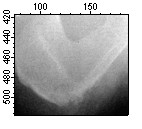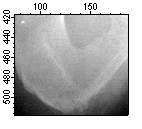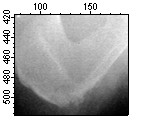
The ImageRegistration operation is based on an algorithm described by Thevenaz, P., and M. Unser, "A Pyramid Approach to Subpixel Registration Based on Intensity," IEEE Transactions on Image Processing, 7, 27-41, 1998.
The operation is designed to register 2D or 3D images (possibly of different modalities) that have sufficiently similar features. The operation will not work if key features are too different. For example, ImageRegistration can handle two images that are rotated relative to each other by a few degrees, but cannot register images if the relative rotation is as large as 45 degrees. The algorithm is capable of sub-pixel resolution but it does not handle large variations between the test image and the reference image. If the centers of the two images are too far from each other, you should first try to remove the translation offset before proceeding with a finer registration of details.
The algorithm is based on an iterative processing that proceeds from coarse to fine detail. Optimization uses a modified Levenberg-Marquardt algorithm and produces an affine transformation for the relative rotation and translation as well as for isometric scaling and contrast adjustment. The algorithm is most effective with square images where the center of rotation is not far from the center of the image.

The first image showing a portion of human pelvic region with a single bright registration marker.

The second image of the pelvic region translated relative to the original image

The registered image.
In this example the following coefficients were computed:
dx= -5.595452275E-01, dy= -1.001775965E+00

Forum

Support

Gallery
Igor Pro 10
Learn More
Igor XOP Toolkit
Learn More
Igor NIDAQ Tools MX
Learn More